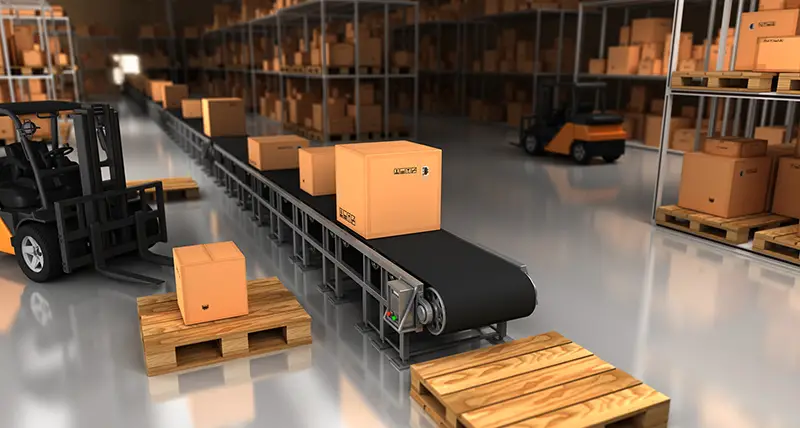Click here to get this post in PDF
Most folks have probably not heard of a palletizer unless they have worked in the manufacturing and production of significant product content that is then packaged and shipped from the same facility. Palletizing involves an efficient and space-sensitive approach to moving as much product as possible in the easiest way possible. In most cases, that means packing products in shipping containers that can be packaged together and then moved quickly as a bundle, stack or aggregate package. Loading uniform packaging onto a pallet adds a significant advantage because it can be moved by forklifts quickly, and the pallets can be loaded and unloaded efficiently from trains, planes and shipping as well with cabling and cranes.
Today’s palletizing happens with a palletizer machine. This is a mechanized system designed to stack, position and combine multiple similar container units together into a pallet and prepare them for reliable and stable movement in bulk. Naturally, the bigger the package number, the easier it is to palletize. The pallet element involves the wood pallet placed underneath the containers designed to provide a solid floor through which a forklift or straps can be inserted to then lift the bundle and pallet en masse.
The key advantage of palletizing involves the concept of unit load. Smaller uniform loads can be placed and positioned together to move them as one larger load. This requires standardization of packaging and packing. Doing so provides economies of scale, and cost savings when moving large amounts of inventory. Boxes, trays, cases and similar containers are the norm, with the containers themselves designed to be placed, stacked and positioned easily. Milk crates are an easy example, where the crate is uniform for easy storage, stacking and movement onto a pallet, even though the milk container itself is fragile and round-shaped carrying the liquid.
Materials
Palletizers work with one of the three categories of pallet systems or else a separate one for cardboard packaging (lightweight product). The pallet most people think of is known as GMA. This is an almost square floor made of wood measuring 40 x 48 inches. It includes slots for a forklift function or straps to lift the load.
The second two are CHEP and PECO. They are distinguished by coloring, blue and red respectively.
The Machines
A palletizer machine is designed to be specific to a type of pallet material, and processes the movement of unit goods into position on the pallet, secures them with strapping or plastic wrap, and then moves the pallet on to a position where it can be lifted and moved to storage or transport. Most palletizer machines are large systems, with a high aerial range to allow the mechanical movement involved.
A floor-level palletizer requires a large footprint and a feeder path that flows product units into the processing section, where they are stacked, positioned and wrapped on the standard pallet type used. The entire process tends to be fully automated with some of the most modern palletizers, with only the feed of product and pallet supply requiring additional movement into the system. Everything happens at eye level, making it easy for an operator to monitor activities and spot problems quickly.
Alternatively, high-level type palletizers are designed for elevated packing systems that work above other working areas. This is also a system used for stacking multi-level pallet combinations. Once complete, the finished pallet stack is then lowered to a discharge path and rolled or moved out of the system to distribution. The operator has to be at a higher point still to be able to see the entire operation and monitor for issues. No surprise, a monitoring station is built with the system for the proper elevation. Taking advantage of gravity, many high-level palletizers move different functions of the process from a high point to a lower point. An inclined path or conveyor belt is common, with modern examples including complex movement paths found in Amazon warehouse distribution centers.
Going Futuristic
A palletizing conveyor system involves a completely different approach than the above. Using computers, visual sensors and robotics, these systems involve a feed belt and a robotic arm that takes the product unit and moves it into place in the pallet grouping being constructed. Like a person, the robotic arm assembly picks up the box or crate, puts it into position on the pallet exactly as necessary using computer sensors, and complete the process 24/7. As long as units are fed through the conveyor belt and pallets are moved into place, the robotic system can continue day and night loading and stacking. These systems work for smaller operations as well as bigger ones, especially with sensitive and fragile product packaging.
Match the Equipment to the Need
Remember, a lot depends on the product and unit container being stacked and palletized. So not every palletizing machine works for every situation. Rather than forcing the product or warehouse to the machine, the goal and product end results should dictate the machine used instead. Whether conventional or robotic, using this approach enhances what already exists versus forcing everything to change to a system that was not a good match to begin with.
You may also like: The Ins and Outs of Pneumatic Conveying
Image source: Shutterstock.com

